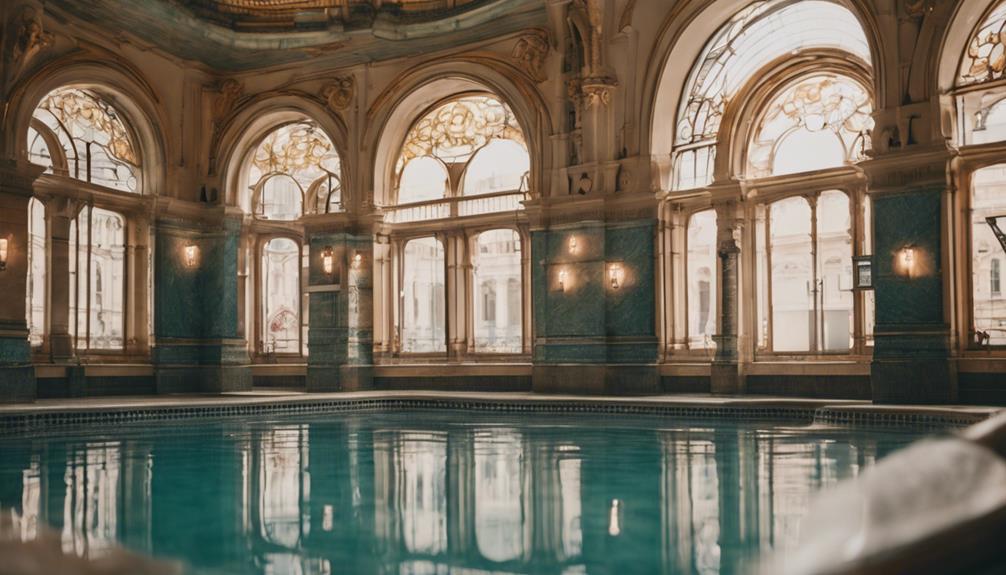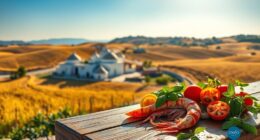Explore Budapest's historic baths for a blend of Roman, Greek, and Turkish architecture. From the Art Nouveau style to intricate designs, like mosaics and stained glass, each bath tells a tale. Gellért, Rudas, and Széchenyi baths showcase unique elements such as Neo-Baroque and Ottoman influences. These baths, blending history and modernity, attract millions yearly. With over 70 million liters of thermal water daily, Budapest's spas promote wellness and Hungarian culture. Immerse yourself in thermal pools, enjoy Hungarian massages, and savor the vibrant social ambiance. The stunning architecture and centuries-old traditions make Budapest's baths a must-visit destination.
Key Takeaways
- Budapest's baths showcase Roman, Greek, and Turkish architectural fusion.
- Unique styles like Art Nouveau, Neoclassical, and Ottoman influence the baths.
- Preservation of diverse architectural styles is vital for Budapest's heritage.
- The baths serve as cultural hubs with historical and contemporary elements.
- Thermal waters promote wellness and community gatherings in Budapest's iconic baths.
History of Budapest's Baths
Exploring Budapest's Baths' historical origins takes us on a fascinating journey through over 2,000 years of bathing culture. Budapest, with its rich history dating back to the fourth century BC, is renowned for its abundance of thermal water sources.
The Romans were among the first to recognize the healing properties of these thermal waters, laying the foundation for Budapest's iconic baths. Over time, Hungarian spas have evolved, blending Roman, Greek, and Turkish architectural elements into stunning structures that serve as both bathing facilities and national monuments.
The Art Nouveau style, prevalent in many of Budapest's baths, adds a touch of elegance to the historical sites. These baths haven't only provided physical therapies for various health conditions but have also been integral to Hungary's cultural heritage, serving as centers of social life for centuries.
Today, visitors can still experience the therapeutic benefits of Budapest's thermal waters while immersing themselves in the city's enthralling history.
Architectural Styles in Hungarian Spas

When exploring the architectural styles in Hungarian spas, you'll find a fascinating blend of influences that create visually stunning designs.
From Roman and Greek elements to Ottoman and modern influences, each spa showcases a unique combination of styles.
Spa Architectural Influences
With a blend of Roman, Greek, and Turkish architectural elements, Hungarian spas create a distinctive and diverse style that captivates visitors with its rich historical influences.
Budapest's thermal baths, such as Gellért, Rudas, and Széchenyi Bath, showcase unique architectural styles that reflect the country's thermal springs and historical connections.
Gellért Baths boast stunning Art Nouveau architecture, characterized by intricate mosaics and stained glass windows that enchant visitors.
Rudas Bath offers a blend of Ottoman and modern design, providing a glimpse into Hungary's architectural influences over the centuries.
Széchenyi Bath stands out as a Neoclassical masterpiece, incorporating elements of Art Nouveau and Neo-Baroque, attracting millions of visitors annually to its grandeur.
These architectural influences not only enhance the spa experience but also contribute to Budapest's status as a city renowned for its historic thermal baths and architectural marvels.
Modern Spa Designs
Modern spa designs in Hungarian spas seamlessly blend historical architectural influences with contemporary amenities, creating a luxurious and rejuvenating experience for visitors.
Hungarian spas draw from Roman, Greek, and Turkish styles, resulting in unique and mesmerizing architectural compositions. The Gellért Baths, known for their exquisite Art Nouveau elements, have even served as a backdrop for various film productions due to their mesmerizing beauty.
At Rudas Bath, guests can explore a museum showcasing ancient Roman bath ruins alongside state-of-the-art spa facilities, offering a glimpse into the historical evolution of spa culture.
Széchenyi Bath, with its impressive Neoclassical design and therapeutic thermal pools, annually entices millions of visitors seeking relaxation and wellness in a modern yet historically rich setting.
These modern spa buildings not only provide contemporary amenities but also serve as architectural masterpieces that seamlessly integrate the past with the present, ensuring a truly unforgettable spa experience in Hungary.
Cultural Significance of Budapest's Baths

The cultural significance of Budapest's baths extends far beyond mere relaxation and leisure, deeply intertwined with the city's historical fabric and societal traditions. These thermal waters have been a crucial part of Hungarian culture for centuries, offering not just healing properties but also serving as communal spaces where social gatherings, artistic events, and traditional ceremonies take place.
The unique architectural significance of Budapest's baths, blending Art Nouveau styles with Roman, Greek, and Turkish elements, showcases the city's rich history and diverse influences.
As public baths, these establishments hold a special place in the hearts of locals and visitors alike, embodying the essence of Budapest's spa culture. The combination of historical importance, architectural beauty, and therapeutic benefits makes these baths more than just places to bathe; they're symbols of the city's cultural identity and national pride.
Whether you visit the Gellért Baths, Rudas Bath, or any of the other iconic thermal spas in Budapest, you aren't only experiencing relaxation but also immersing yourself in a centuries-old tradition that continues to shape the city's cultural landscape.
Designs of Budapest's Historic Baths

Explore the diverse architectural styles of Budapest's historic baths, including Art Nouveau, Neo-Baroque, and Ottoman influences.
Discover the intricate mosaics and stained glass windows at Gellért Bath, the Neoclassical elegance of Széchenyi Bath, and the blend of Ottoman and modern design at Rudas Bath.
Each bath offers a unique glimpse into the city's cultural heritage, making them iconic landmarks in Budapest.
Architectural Styles
Amid Budapest's historic baths, you'll encounter a fascinating array of architectural styles, including Art Nouveau, Neoclassical, and Ottoman influences. Each bath has its unique design reflecting a blend of these influences.
Gellért Bath stands out with its Art Nouveau elements, showcasing intricate mosaics and stunning stained glass windows that capture the essence of this style.
Széchenyi Bath, on the other hand, boasts a remarkable Neoclassical design, blending Art Nouveau and Neo-Baroque features to create a grand architectural masterpiece.
Rudas Bath offers a different experience, combining Ottoman influences with modern design sensibilities to create a distinctive ambiance that transports you to another era.
These diverse architectural styles not only contribute to the beauty of Budapest's historic baths but also provide a glimpse into the cultural and historical significance of these iconic landmarks. Each bath tells a unique story through its architecture, inviting visitors to explore and appreciate the rich heritage of these historical sites.
Cultural Significance
Immerse yourself in the rich cultural significance of Budapest's historic baths through their enchanting blend of architectural styles, including Art Nouveau, Neo-Baroque, and Ottoman influences.
Each bath, such as Gellért Bath and Széchenyi Bath, boasts unique designs like intricate mosaics, stained glass windows, and grand domes that reflect the city's rich architectural heritage.
These historical baths, like Rudas Bath, stand out with their fusion of Ottoman and modern design elements, offering a glimpse into Budapest's diverse architectural history.
The stunning architecture of these baths not only serves as a visual delight but also plays an essential role as a cultural hub.
Millions of visitors are drawn annually to experience the events, concerts, and the relaxing atmosphere these baths provide.
Budapest's historic baths aren't only architectural marvels but also significant cultural landmarks that showcase the city's unique blend of styles and influences.
Preservation of Architectural Heritage

Preserving Budapest's historic baths is essential for safeguarding the city's diverse architectural heritage. The Budapest baths, including the Gellért Bath, Széchenyi Bath, and Rudas Bath, showcase a remarkable mix of architectural styles such as Art Nouveau, Neoclassical, Neo-Baroque, and Ottoman.
Each bath's unique design elements contribute to the city's rich architectural tapestry. The Gellért Bath stands out with its intricate mosaics and stained glass windows in the Art Nouveau style, adding a touch of elegance to its structure.
Széchenyi Bath, a Neoclassical masterpiece, seamlessly blends Art Nouveau and Neo-Baroque features, captivating visitors with its grandeur. Rudas Bath's fusion of Ottoman and modern design creates a memorable architectural experience for those seeking relaxation.
These baths not only serve as cultural hubs but also play an important role in preserving Budapest's architectural heritage, offering visitors a glimpse into the city's past while enjoying therapeutic thermal waters.
Social Importance of Budapest's Baths

The historic baths in Budapest have long served as vibrant hubs of social activity and relaxation, shaping the city's communal fabric for generations. These famous thermal baths offer not only a place to unwind but also an opportunity to connect with others.
Locals and visitors alike flock to these architectural marvels, taking the best of what the City of Baths has to offer. The Art Nouveau design of many of Budapest's baths adds to their allure, creating a stunning backdrop for social interactions. Whether you're looking to relax in a thermal pool, enjoy a traditional Hungarian massage, or simply explore the intricate architecture, Budapest's baths provide a guide to the best in wellness and social connection.
With over 70 million liters of thermal water flowing through the city's spas daily, it's clear that these baths hold a significant social importance in Hungarian culture, promoting wellness and community gatherings since the 18th and 19th centuries.
Frequently Asked Questions
What Is the Architectural Style of Budapest?
In Budapest, the architectural style is a diverse mix consisting of Baroque, Art Nouveau, Renaissance-Revival, Neoclassical, and Neo-Baroque elements. The city's buildings display a rich tapestry of historical influences, creating a unique visual landscape.
This blend of styles reflects Budapest's complex cultural heritage and gives rise to the stunning architectural diversity found throughout the city.
Explore these various architectural styles to gain a deeper appreciation of Budapest's historical and cultural significance.
What Is the Architecture of the Szechenyi Baths?
The architecture of Széchenyi Baths in Budapest combines Neoclassical, Art Nouveau, and Neo-Baroque styles. The baths boast a grand entrance hall, intricate mosaics, and stunning colonnades.
The iconic yellow facade and symmetrical layout are true to Neoclassical design principles. With 18 pools, indoor and outdoor, set amidst beautiful gardens and statues, visitors can soak in therapeutic thermal waters while marveling at the architectural details.
What Is the History of the Budapest Baths?
To understand the history of Budapest's baths, you need to explore their origins dating back to the fourth century BC, influenced by Roman bathing culture.
The Ottomans further enriched this tradition by constructing iconic baths like Rudas and Veli Bej, showcasing the city's diverse cultural influences.
Later, the Hapsburgs elevated Budapest's bathing culture by adding Széchenyi and Gellért complexes, featuring a blend of Baroque, Art Nouveau, and Renaissance-Revival architecture.
What Is Special About Budapest Spa?
To understand what makes Budapest spas special, consider their healing properties and cultural significance. These thermal baths offer more than relaxation, with mineral-rich waters providing therapeutic benefits for various health conditions.
Additionally, these spas aren't just places of leisure but also serve as national treasures, boasting unique architectural designs that blend historical charm with modern amenities.
Visitors are drawn to Budapest's iconic baths for their rich history, stunning architecture, and rejuvenating experiences.
Conclusion
To sum up, Budapest's historic baths offer a unique blend of architectural beauty and cultural significance. By exploring the various styles and designs of these iconic spas, visitors can appreciate the rich history and social importance of these landmarks.
Whether you're a history buff or simply looking to relax in a stunning setting, Budapest's baths are a must-visit destination that showcases the city's rich heritage and architectural splendor.





